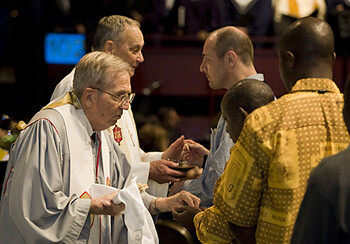
Bishop opens General Conference 2008 with 'resurrection hope'
April 23, 2008
NOTE: Photographs are available at http://umns.umc.org/.
By Erik Alsgaard*
 On the 40th anniversary to the day of the creation of The United Methodist Church, and within 40 miles of where it happened, United Methodists from 129 annual conferences and 50 countries gathered at the Fort Worth (Texas) Convention Center for the start of the 2008 General Conference.
On the 40th anniversary to the day of the creation of The United Methodist Church, and within 40 miles of where it happened, United Methodists from 129 annual conferences and 50 countries gathered at the Fort Worth (Texas) Convention Center for the start of the 2008 General Conference.
Under the leadership of Marcia McFee of Truckee, Calif., and Mark Miller of Plainfield, N.J., co-music directors for the General Conference, more than 6,500 people filled the arena Wednesday night for a two-hour worship service.
The rousing worship featured praise bands, a full orchestra, choirs, music, prayers and Scripture in many tongues, and symbols of the Christian faith using ordinary elements of glass, wood, bread, fruit of the vine and water.
Bishops Gregory Palmer, Iowa Area, and Janice Riggle Huie, Houston Area, led the service of Holy Communion, with the Lords' Prayer being offered by each worshipper in his or her own native language.
Gathering around a table cast in the middle of the nearly 1,000 delegates seated on the arena floor, the gospel was read, the bread broken and the cup poured out.
The wood used to create the pulpit, the altar and the table was taken from the "hallowed grounds" of Gulfside Assembly in Waveland, Miss., noted McFee at the start of the worship service. Gulfside was completely destroyed by Hurricane Katrina in 2005.
Amid the pageantry, pomp and circumstance as bishops, banners and believers bedecked the arena, Bishop Huie's sermon sounded a clear call that, even in the midst of a world filled with AIDS, malaria, violence, global climate change and fear, United Methodists are called to live a life with hope - resurrection hope.
Preaching from Romans 8:18-28, Bishop Huie said that today, the word "hope" was becoming a "marshmallow word. It sounds soft. It looks sweet and appealing. Get it close to the fire, and hope melts off the stick and drips on the ground."
Interrupted by applause on several occasions, Bishop Huie said that hope is not only the theme of this 2008 General Conference, it is the "nerve center" of the Christian life.
"It is impossible to live without hope," she said. "Show me someone without hope and I will show you someone who is either dead or so desperate that they are capable of the most awful violence."
To counter this sense of hopelessness, we have our Bible, which the bishop said is nothing but a story of hope.
"The Apostle Paul paints hope on a cosmic canvas of salvation history," Bishop Huie said. "The focal point of the painting is the resurrection of Jesus Christ.
"Resurrection hope transforms lives and changes the future," the bishop said. "Tonight, through us, the people of The United Methodist Church gather around this table filled with resurrection hope.
"Hope is the nerve center of the Christian life," said Bishop Huie. "Love is the heart. Faith is the muscle. It is impossible to live without hope."
The bishop related stories of visits she made to local churches in Arkansas and Texas, the two episcopal areas she has served. On those visits, she often asked about the church's mission.
"I've lost count of the number of times I've heard this response: ‘Mission? We just hope we can survive another year.'"
When Paul used the word "hope" five times in this Scripture, Bishop Huie said, "He was not describing a sweet, sappy kind of hope that evaporates in the noonday sun. He is not describing wishful thinking. He is describing the sure confidence of a future reality."
That reality, grounded in the resurrected Christ, causes disciples to "wait with eager longing and unfettered imaginations to discover where God is already at work in the world and join with God in that transformation."
The bishop shared a poignant story she learned from Elizabeth McKee Gore, a United Methodist laywoman who works at the United Nations Foundation with the Nothing But Nets campaign to eradicate malaria.
While on a trip to Angola, Elizabeth met Esperanca Afonco, an 8-year-old girl. Esperanca was sick and in the hospital with both AIDS and malaria. The doctors had given her only weeks to live.
Bishop Huie said that Elizabeth wrote about meeting Esperanca at the hospital. What struck her was that in the hospital, Esperanca's mother, Bela, had decorated the bed to look like it was fit for a Disney World princess. A pink bed net was draped over the bed, the dolls and the child.
Even Esperanca was pretty in a pink dress. All this in contrast to the drab surroundings of the other beds in other wards, filled with two or three to a bed.
The doctor asked Bela, "Why have you worked so hard to create such a lovely environment?"
The mother replied: "We have to have hope."
"Resurrection hope gives us the courage to stand beside the bed of a loved one with terminal disease," Bishop Huie said. "Resurrection hope overcomes the insults of institutional racism. Resurrection hope plants new seed when the rains finally come. Resurrection hope rebuilds homes and lives after a storm.
"We are no longer captives to fear. We are heirs to a new covenant - a new future."
And please, the bishop said to the church, do not forget Esperanca this week.
"In Portuguese," Bishop Huie said, "Esperanca means ‘hope.'"
*Alsgaard is director of communications for The United Methodist Church's Florida Annual Conference.

Login/Register to leave comment